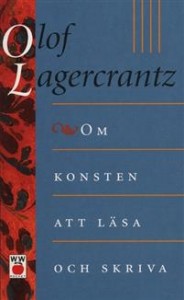 One of my favorite books about reading and writing is a luminous essay by the late Swedish poet, literary biographer, and newspaper editor Olof Lagercrantz (1911–2002). Entitled Konsten att läsa och skriva (The Art of Reading and Writing), it came to my rescue as I wrote my one and only book in Swedish. Though I had had only five years of school in Sweden before my family moved to Geneva, I knew that my book about my mother, Alva Myrdal, had to be in my mother tongue. I could then go on to translate it into English and expand it into what became Alva Myrdal: A Daughter’s Memoir.
One of my favorite books about reading and writing is a luminous essay by the late Swedish poet, literary biographer, and newspaper editor Olof Lagercrantz (1911–2002). Entitled Konsten att läsa och skriva (The Art of Reading and Writing), it came to my rescue as I wrote my one and only book in Swedish. Though I had had only five years of school in Sweden before my family moved to Geneva, I knew that my book about my mother, Alva Myrdal, had to be in my mother tongue. I could then go on to translate it into English and expand it into what became Alva Myrdal: A Daughter’s Memoir.
I have long admired Lagercrantz’s vivid, memorable studies of works by Dante, Joyce, Conrad, Proust, Strindberg, and others. He was a writer of extraordinary simplicity and grace, whose style has been compared, in its force and seemingly effortless elegance, to that of a great long-distance skater moving across the ice. Almost as an aside, he published his small jewel on reading and writing—no textbook, as he points out in his preface, but “shards only, observations and memories from a life spent in the land of reading and writing.”
When I wrote Lagercrantz to ask permission to translate this book into English, he kindly agreed. One summer, I spent a few afternoon hours a day translating a page or two at a time, relishing the opportunity to look for the right word, think through what he might have meant, at times ask him questions about particular expressions.
The book begins by asking:
What happens when we read? The eye follows black letters on white paper, from left to right, over and over. And creatures, nature, or thoughts that another has thought, recently or a thousand years ago, appear in our imagination. It is a miracle greater than that a grain of corn from the graves of the Pharaos is made to sprout. And it happens every moment.
In a later chapter on writing, is another passage that I find indispensable:
Rainbows, rockets, slivers of mirror and arrows are important for a good text. I mean by that connections between different times, places, consciousnesses and aims that point backwards and forwards. As the tale moves along, its kernel must lie still while everything around it is in motion.

